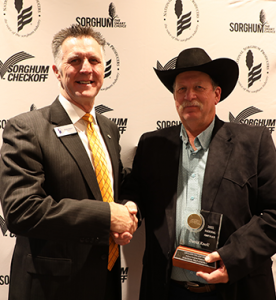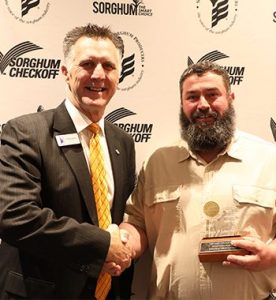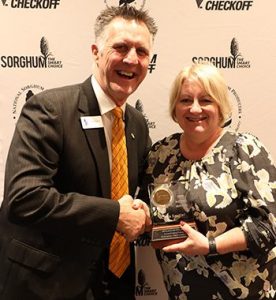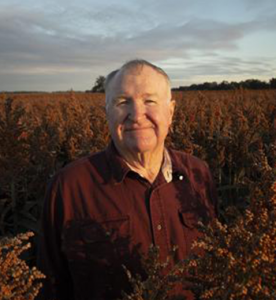
Swipe For More >
National Sorghum Producers Yield Contest Winners 2021
The 2021 yield contest winners were honored at Commodity Classic in New Orleans. Learn how the national first place winners earned their top spots in the contest.
 David Knoll Charles Mix County, SD | Dryland-Tillage Western
David Knoll Charles Mix County, SD | Dryland-Tillage Western
A pleasantly surprising growing season granted David Knoll just over 170 bushels per acre to win the dryland-tillage west category. Knoll managed his sorghum by staying on top of weed control and planting in more narrow rows to shade the crop in order to reduce moisture loss, he said. Soil tests are a management practice he uses to gain more knowledge about his field’s fertility. He applied 100 pounds of nitrogen and 50 pounds of phosphorus to supplement the field. Knoll said tillering helped his overall yield performance. He chooses to market his crop through specialty markets and for cattle feed. “I feel lucky and blessed [to be a sorghum yield contest winner],” Knoll said, adding he is appreciative to receive acknowledgement for his success while capitalizing on the opportunity to meet other producers and industry leaders.
 Harry P. Johnston Fulton County, PA | Dryland-Tillage Eastern
Harry P. Johnston Fulton County, PA | Dryland-Tillage Eastern
Although Harry Johnston’s crop received less rain than what is typical, he praises sorghum for remaining steadfast and drought-tolerant during the dry spells, leading him to win the dryland-tillage east category. “The plot both met and exceeded my expectations with the drier weather we had in July 2021,” he said. Johnston chooses sorghum for its ability to withstand pressure from deer and because it works well in his crop rotation. Soil tests were an essential component to Johnston’s management plan, and he used this data to apply the specified nutrients that were lacking when he received the results of the samples. He applied 200 pounds of nitrogen, 120 pounds of phosphorus, 80 pounds of potash and 6,000 gallons of swine manure. To add to that, he kept a close watch on pest control in order to prevent any outbreaks. Johnston markets his harvested crops to a local mill that processes it for birdseed.
 Kasey Gamble Kiowa County, KS | Dryland-No Till Western
Kasey Gamble Kiowa County, KS | Dryland-No Till Western
Growing a winning sorghum crop is in the management details according to Kasey Gamble, winner of the dryland-no till west category and 2022 Bin Buster. “I make sure that every tool is in the toolbox in regards to fertilizer, herbicide, insecticide and fungicide,” he said. “If you want big yields, you have to use the tools and spend some money, and you’ll be rewarded.” Gamble emphasized spraying wheat stubble to maintain a weed-free field and combat any volunteer wheat was essential to prevent it from siphoning the moisture needed for a successful sorghum crop. This was his first year to use fungicide to maximize the potential yield in that field. To add to that, the weather was in Gamble’s favor with ample rainfall in July and August, combined with appropriate temperatures for the growing season. Gamble markets his crop directly with Smithfield Foods. His impressive 244 bushel yield is the highest in contest history for dryland west of the Mississippi River.
 Chris Santini Warren County, NJ | Dryland-No Till Eastern
Chris Santini Warren County, NJ | Dryland-No Till Eastern
Favorable weather conditions pushed Chris Santini’s crop to the top of the dryland-no till east category with the help of 60 inches of rain during the growing season. “The weather was in our favor this year,” Santini said. “It was perfect growing conditions, and the sorghum was never stressed.” Santini said past growing seasons led to the decision to plant their crop earlier than the end of May this past growing season, and they marginally increased their seed population to 100,000. Santini also used 2.5 tons of poultry manure as fertilizer to contribute to soil nutrient levels and Lumax pre-emergent herbicide to control weed growth. Her marketing program targets the birdseed industry, selling to a nearby mill.
 Tom Vogel Hartley County, TX | Irrigated Western
Tom Vogel Hartley County, TX | Irrigated Western
Meeting and surpassing goals is always a triumph when it comes to farming, and Tom Vogel did just that last year with his sorghum crop, winning the irrigated west category. “We were going for 10,000 pound milo, [and] we exceeded that on a 170 acre circle,” he said. Vogel credits a meticulous use of management tools like starter fertilizer, pre and post-emergent chemicals and fungicide for his successful crop. Vogel used a 24-row planter to apply a 10-34-0 starter, 24 ounces of generic metolachlor and 16 ounces of Atrazine for pre-emerge. At 5-6 leaf stage he used 16 ounces of Husky and 16 ounces of Atrazine, and lastly, he used a fungicide to promote crop health and protect against diseases. The crop was double crop sorghum, planted strip till into wheat stubble on June 10. While rainfall was short in the months of June and July, a late freeze in the middle of November helped his sorghum finish.
 Mike Scates White County, IL | Irrigated Eastern
Mike Scates White County, IL | Irrigated Eastern
Mike Scates’ winning irrigated east category yield contest plot was planted at 130,000 seeds per acre with 30-inch row spacing to produce an impressive 182.24 bushel per acre yield. Scates previously had soybeans on his contest field and used pivot irrigation to maintain proper soil moisture. He added 225 pounds of anhydrous ammonia, 125 pounds of phosphorus and 175 pounds of potash to enhance the soil’s nutrient profile.
Congratulations to the 2021 Winners! Entries for the 2022 Sorghum Yield Contest are NOW OPEN! For entry form and rules, visit SorghumGrowers.com/yieldcontest/.
###
This story originally appeared in the Spring 2022 Issue of Sorghum Grower magazine.


